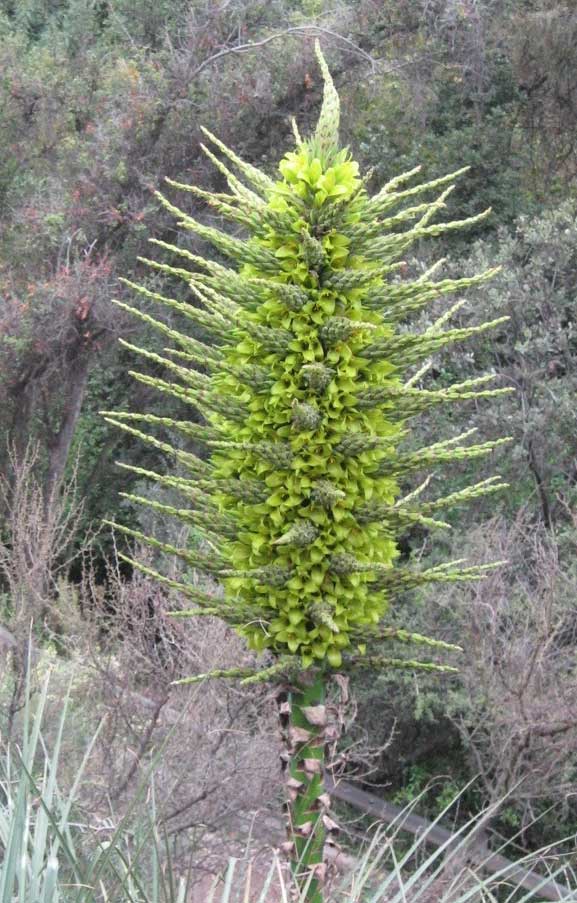
Puya chilensis (*)
Classification System: APG IV
Superregnum: Eukaryota
Regnum: Plantae
Cladus: Angiosperms
Cladus: Monocots
Cladus: Commelinids
Ordo: Poales
Familia: Bromeliaceae
Subfamilia: Puyoideae
Genus: Puya
Species: Puya chilensis
Name
Puya chilensis Molina (1782)
Synonyms
Homotypic
Pitcairnia chilensis (Molina) Lodd. ex Loudon, Hort. Brit.: 118. 1830.
Heterotypic
Pitcairnia coarctata (Ruiz & Pav.) Pers., Syn. Pl. 1: 344. 1805.
Pourretia coarctata Ruiz & Pav., Fl. Peruv. 3: 34. 1802.
Puya chilensis var. gigantea (Phil.) Baker, Handb. Bromel. 127. 1889.
Puya coarctata (Ruiz & Pav.) Fisch., Sert. Petrop. t. 19. 1869.
Puya gigantea Phil., Linnaea 33: 246. 1865.
Puya quillotana W.Weber, Feddes Repert. 95: 577. 1984.
Puya suberosa Molina, Sag. Stor. Nat. Chili 153. 1782.
References
Molina, J.I. 1782. Saggio sulla Storia Naturale del Chili. Stamperia di S. Tomaso d'Aquino: Bologna. 367 pp. Reference page. Original description p.160
Govaerts, R. et al. 2010. Puya chilensis in World Checklist of Selected Plant Families. The Board of Trustees of the Royal Botanic Gardens, Kew. Published online. Accessed: 2010 Sept 06. Reference page.
Vernacular names
English: Puya
español: Chagual
Puya chilensis is a terrestrial bromeliad originating from the arid hillsides of Chile.
Description
An evergreen perennial, it forms large, dense rosettes of grey-green, strap-like leaves edged with hooked spines. The green or yellow flowers are borne on spikes which resemble a medieval mace, and stand up to 2 m (6 ft 7 in) high. Spreading by offsets, Puya chilensis can colonise large areas over time. Growth is slow and plants may take 20 years or more to flower. The outer two-thirds of the leaf blade bears outward-pointing spines which may be an adaptation to prevent herbivores from reaching the center of the plant.[1] The plant is believed to be hazardous to sheep and birds which may become entangled in the spines of the leaves.[2] If the animal dies, the plant may gain nutrients as the animal decomposes nearby, though this has not been confirmed.[2] For this reason, Puya chilensis has earned the nickname "sheep-eating plant".[3] If true, this would make Puya chilensis a protocarnivorous plant. Fibers from the leaves are used to weave durable fishing-nets.[2]
Natural habitat
Puya chilensis growing in habitat at La Campana National Park
It is commonly found on arid hillsides of the Andes, on north-facing slopes of matorral areas at 300–1,000 m (980–3,280 ft) above sea level.
Conservation
Puya chilensis is not considered threatened. It is also cultivated in many parts of the world.
In its natural arid environment, plants can be highly flammable and are susceptible to damage from fires that are often the result of human action. Land clearance is an increasing threat.
References
"Ficha de Especie Clasificada: Puya chilensis" (PDF). Clasificación de Especies (in Spanish). Ministerio del Medio Ambiente. 2010. Retrieved 21 June 2013.
Mabberley, D.J. (1997). The Plant Book (Second ed.). Cambridge: Cambridge University Press. p. 599. ISBN 0-521-41421-0. Retrieved 21 June 2013. "puya chilensis birds."
"Sheep-Eating Plant Opens Up After 15 Years : DNews". DNews. Retrieved 2015-11-30.
Further reading
Shaw, Christine 2005. Architectural Plants. ISBN 0-00-720470-1
Miles, Tim & Rowe, David & Smit, Tim 2003. The New Cornish Garden. ISBN 1-85022-174-X
Retrieved from "http://en.wikipedia.org/"
All text is available under the terms of the GNU Free Documentation License

